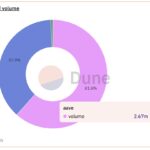In a recent report from the investment bank Jefferies, figures show that Bitcoin (BTC) mining profitability saw a notable decline of 7.4% in March. This downturn was primarily driven by a significant 11.2% drop in the average price of Bitcoin and a 9.1% reduction in transaction fees. As miners navigate this challenging landscape, U.S.-listed companies successfully extracted a total of 3,534 bitcoins in March, up from 3,002 in February, marking a slight increase in production despite the profitability challenges.
Jefferies highlighted that these U.S.-listed miners accounted for 24.8% of the entire Bitcoin network’s output last month, a modest increase from 23.6% previously. Among these miners, Marathon Digital Holdings (MARA) led the pack by producing 829 bitcoins in March, followed closely by CleanSpark (CLSK) with 706 BTC. Furthermore, Marathon dominated in terms of mining capacity, boasting the highest installed hashrate of 54.3 exahashes per second, while CleanSpark followed with an impressive 42.4 EH/s.
As the new month unfolds, Jefferies points out that Bitcoin prices have remained relatively stable, particularly when contrasted with the S&P 500 stock index, which has experienced a decline of 6%. The report suggests that the recent weakness of the U.S. dollar may be contributing to Bitcoin’s current resilience in the market. Industry players and analysts alike are keeping a close eye on these developments, as the landscape of cryptocurrency continues to evolve.

Impact of Bitcoin Mining Profitability Decline in March
The decline in Bitcoin mining profitability has several implications for investors and the overall market. Here are the key points to consider:
- Mining Profitability Decrease:
- Bitcoin mining profitability fell by 7.4% in March.
- This decline was attributed to a 11.2% drop in average Bitcoin prices and a 9.1% reduction in transaction fees.
- Mining Output Comparison:
- U.S.-listed miners produced 3,534 BTC in March, up from 3,002 BTC in February.
- These miners accounted for 24.8% of the total Bitcoin network, a slight increase from 23.6%.
- Leading Miners:
- MARA Holdings (MARA) topped production with 829 BTC.
- CleanSpark (CLSK) followed with 706 BTC.
- MARA also led in installed hashrate at 54.3 EH/s.
- CleanSpark ranked second with 42.4 EH/s.
- Market Conditions:
- As of April, Bitcoin prices remained largely unchanged while the S&P 500 index fell 6%.
- The weakness of the U.S. dollar could be influencing Bitcoin’s relative performance.
Investors should consider the impact of decreased mining profitability on the overall Bitcoin ecosystem and potential investment strategies.
March Sees Decline in Bitcoin Mining Profitability: A Competitive Analysis
This month’s report from Jefferies indicating a 7.4% drop in Bitcoin mining profitability prompts a closer examination of the competitive landscape within the mining industry. With Bitcoin prices experiencing an 11.2% decline alongside reduced transaction fees, the data highlights significant challenges for miners. Despite these hurdles, U.S.-listed miners managed to increase their output from the previous month, which may seem like a silver lining in a generally bleak financial context.
Competitive Advantages: Notably, MARA Holdings emerged as the dominant player, extracting 829 BTC in March, capitalizing on its robust hashrate of 54.3 EH/s. This performance positions MARA favorably, creating a competitive edge against peers. CleanSpark also showed strength, ranking second in production and maintaining a strong hashrate, which might enhance investor confidence in its operational efficiency. For these companies, the ability to scale up production amidst declining profit margins can attract new investments and maintain market share, further solidifying their position in a turbulent market.
Disadvantages and Potential Pitfalls: On the flip side, overall profitability concerns signal potential issues for miners with less operational efficiency or higher costs. The 9.1% decrease in transaction fees could particularly impact smaller miners who are less resilient in downturns. As larger entities like MARA and CleanSpark capitalize on economies of scale, boutique mining firms might struggle to keep pace, leading to market consolidation. Furthermore, the decreasing profitability amid a generally sluggish market could deter new entries into Bitcoin mining, stifling innovation and diversity in the space.
As we look ahead, these market dynamics suggest that existing players who can optimize their operations will likely thrive, while newcomers could face significant barriers. Investors might find opportunities in dominant firms that can weather the storm, yet the overall trend could create uncertainty for those with less capital or operational flexibility. The contrasting fortunes of these mining firms illustrate the challenging landscape of cryptocurrency mining, one where adaptability will be key to survival.

















